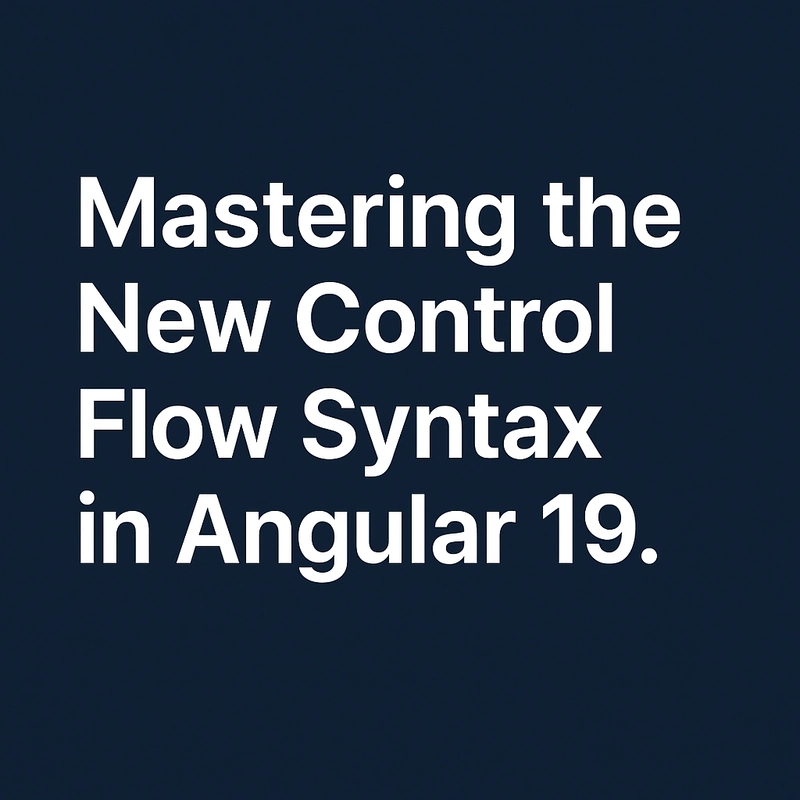Mastering the New Control Flow Syntax in Angular 19
With the release of Angular 19, the Angular team has fully embraced the new control flow syntax, marking a significant evolution in template ergonomics and reactivity. Initially introduced in Angular 17, this syntax is now stable, highly performant, and recommended for production use. If you're still using *ngIf, *ngFor, and *ngSwitch, it's time to upgrade your mental model—and your templates. What Is the New Control Flow Syntax? The new control flow in Angular 19 introduces block-level structural directives such as @if, @for, and @switch. These constructs offer a clearer, more declarative, and type-safe approach to writing dynamic templates. Comparison: Traditional vs. New Syntax Traditional (Pre Angular 17): Hello, {{ user.name }} {{ item }} Modern (Angular 19): @if (user) { Hello, {{ user.name }} } @for (item of items; track item.id) { {{ item }} } New Syntax Breakdown @if / @else / @else if @if (user) { Welcome, {{ user.name }} } @else if (isGuest) { Welcome Guest } @else { Please log in } @for @for (hero of heroes; track hero.id) { {{ hero.name }} } @switch / @case / @default @switch (status) { @case ('loading') { Loading... } @case ('success') { Loaded successfully! } @default { Error occurred. } } How to Use It If you're using standalone components (which are the default in Angular 19), the new control flow syntax is enabled out of the box. No additional imports are required. Example bootstrap: import { bootstrapApplication } from '@angular/platform-browser'; import { AppComponent } from './app/app.component'; bootstrapApplication(AppComponent); Why Angular Introduced This Improved Developer Experience (DX) Better Type Safety Modernization of Angular's syntax Alignment with future reactivity models (Signals) Performance Considerations The new control flow directives are optimized under the Ivy rendering engine and designed to seamlessly integrate with Angular Signals, enabling fine-grained reactivity. Best Practices Prefer @for over *ngFor Always use track when rendering arrays Use block syntax to improve code clarity Incrementally migrate templates in large apps Final Thoughts Angular’s new control flow syntax simplifies template writing while preparing the ecosystem for its reactive future. It's cleaner, smarter, and designed for scale. Time to say goodbye to stars (*) and hello to at-signs (@). Happy coding with Angular 19! ⚡

With the release of Angular 19, the Angular team has fully embraced the new control flow syntax, marking a significant evolution in template ergonomics and reactivity. Initially introduced in Angular 17, this syntax is now stable, highly performant, and recommended for production use.
If you're still using *ngIf, *ngFor, and *ngSwitch, it's time to upgrade your mental model—and your templates.
What Is the New Control Flow Syntax?
The new control flow in Angular 19 introduces block-level structural directives such as @if, @for, and @switch. These constructs offer a clearer, more declarative, and type-safe approach to writing dynamic templates.
Comparison: Traditional vs. New Syntax
Traditional (Pre Angular 17):
*ngIf="user">Hello, {{ user.name }} Modern (Angular 19):
@if (user) {
Hello, {{ user.name }}
}
@for (item of items; track item.id) {
{{ item }}
}
New Syntax Breakdown
@if / @else / @else if
@if (user) {
Welcome, {{ user.name }}
} @else if (isGuest) {
Welcome Guest
} @else {
Please log in
}
@for
@for (hero of heroes; track hero.id) {
class="card">{{ hero.name }} 



























![[Webinar] AI Is Already Inside Your SaaS Stack — Learn How to Prevent the Next Silent Breach](https://blogger.googleusercontent.com/img/b/R29vZ2xl/AVvXsEiOWn65wd33dg2uO99NrtKbpYLfcepwOLidQDMls0HXKlA91k6HURluRA4WXgJRAZldEe1VReMQZyyYt1PgnoAn5JPpILsWlXIzmrBSs_TBoyPwO7hZrWouBg2-O3mdeoeSGY-l9_bsZB7vbpKjTSvG93zNytjxgTaMPqo9iq9Z5pGa05CJOs9uXpwHFT4/s1600/ai-cyber.jpg?#)














































































































































![[The AI Show Episode 144]: ChatGPT’s New Memory, Shopify CEO’s Leaked “AI First” Memo, Google Cloud Next Releases, o3 and o4-mini Coming Soon & Llama 4’s Rocky Launch](https://www.marketingaiinstitute.com/hubfs/ep%20144%20cover.png)




































































































































































































![Rogue Company Elite tier list of best characters [April 2025]](https://media.pocketgamer.com/artwork/na-33136-1657102075/rogue-company-ios-android-tier-cover.jpg?#)








































































_Andreas_Prott_Alamy.jpg?width=1280&auto=webp&quality=80&disable=upscale#)


























































































![What’s new in Android’s April 2025 Google System Updates [U: 4/18]](https://i0.wp.com/9to5google.com/wp-content/uploads/sites/4/2025/01/google-play-services-3.jpg?resize=1200%2C628&quality=82&strip=all&ssl=1)










![Apple Watch Series 10 Back On Sale for $299! [Lowest Price Ever]](https://www.iclarified.com/images/news/96657/96657/96657-640.jpg)
![EU Postpones Apple App Store Fines Amid Tariff Negotiations [Report]](https://www.iclarified.com/images/news/97068/97068/97068-640.jpg)
![Apple Slips to Fifth in China's Smartphone Market with 9% Decline [Report]](https://www.iclarified.com/images/news/97065/97065/97065-640.jpg)



































































































































